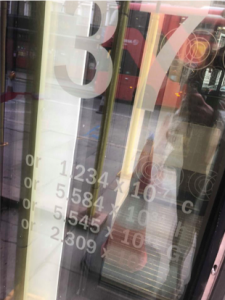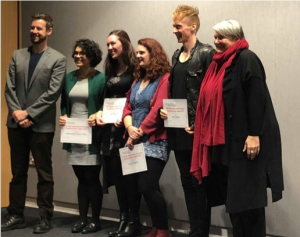November 30, 2018, by Prof Meghan Gray
My first conference ever: personal experiences and what I’ve learned
Guest post by Jo Melton, fourth year MSci Physics undergraduate and aspiring science communicator who has previously played a big role in our social media team.
With the end of my masters course looming, I realised I couldn’t put off the dreaded job search any longer. Throughout my degree I’ve not really given what I’d like to do with my life much thought. I thought to myself ‘as long as it’s science, I’ll be happy’ – but that doesn’t really narrow my options down! I’ve always loved explaining science to people. It’s not unusual to find me in the pub, pint in hand, explaining my research projects to semi-interested people who can’t think of an excuse to leave. It only dawned on me recently – I could do this as my job. Science communication is a very varied, massive field, and I didn’t really know where to start. On Friday 23rd November, the UoN Physics department offered me an amazing opportunity to find out more. I snapped this up, packed my bags and headed down to London. Where better to start than the IOP’s conference on “The Art and Craft of Communicating Physics”.

One 6am start later, I was in the capital city. At first, I was nervous; a northerner in foreign territory. However these tensions were soon eased by the greeting of familiar physical constants on the outside of a building. Indeed, I was at the IOP. The building was nothing but impressive, any nervous feelings were instantly swallowed by a sense of sheer awe. The environment was so pristine I would have happily eaten off the floor, under nothing less than Orion constellation lighting.
 By far my favourite thing about the whole event was meeting other women in STEM. Before I could even step into the conference room, another female physicist called Leonie approached me to say hello! And when I did get in, nearly half of the people there were women! No way am I throwing a pity party over gender imbalances, but it’s sometimes easy to feel a little lost in a sea of Y-chromosomes. Of course lots of women work in STEM, but there’s seldom opportunity to be able to informally chat and get to know them as people. Just as a side note, good on the IOP for getting us all together!
By far my favourite thing about the whole event was meeting other women in STEM. Before I could even step into the conference room, another female physicist called Leonie approached me to say hello! And when I did get in, nearly half of the people there were women! No way am I throwing a pity party over gender imbalances, but it’s sometimes easy to feel a little lost in a sea of Y-chromosomes. Of course lots of women work in STEM, but there’s seldom opportunity to be able to informally chat and get to know them as people. Just as a side note, good on the IOP for getting us all together!
On the subject of science communication itself, the conference was incredibly thought provoking. Introducing the conference was Wendy Sadler, founder of the outreach company Science made Simple. One of the topics of conversation that came up was that single-sex schools are best at getting their pupils into STEM. Probably due to a lack of observation on my part, but at this point I realised that my female physics friends at uni all went to single sex schools. On one hand, this could be due to the fact that the majority of these schools are private. Here, parents may be more inclined to take their children to science events and push them on to further study. But it’s probably because in mixed schools it’s intimidating to sit in a room full of boys! This point comes up time and time again, but physics stereotypes are brought on at a young age. The best way to get more women into STEM is to target children’s beliefs’ way before they choose their GCSEs. This is exactly what Wendy’s company was trying to achieve.
However there was several very interesting points Wendy made that I hadn’t even considered before. She pointed out that outreach needs to be done in the right way, or it can be misleading. It’s our job as scientists to communicate science for everyone; our job isn’t done until we’ve achieved that. However, we always have to back up curiosity with facts. For example, a demonstration of the Bernoulli Effect without context or explanation could be interpreted as something akin to magic – as magical as physics is, this would be incredibly counter-productive! On the other hand we can’t overload people with facts. They switch off. One solution that Wendy offered was ditching the equations, and instead applying a focus to capturing the emotions of the public through creative media and arts. These programmes are often looked down on by mathematicians and students alike. But perhaps this is for the best. In order to reach a wider public audience, should we alienate the scientific community?
Personally, I agree to an extent we need to capture emotions of the public, but I think this can involve maths too, and inspire the public to put the hours in once they see how fun maths can be. But I would say that, I’m a physicist.
Once Wendy had finished, 4 speakers gave a talks on their outreach to try and win the Early Career Physics Award offered by the IOP. It was very inspiring to see all of these. The nominees were PhD students or had just finished their PhDs – not much older than me. It was incredible to see what they had been able to achieve alongside their study.
In the end, the award was given to (the incredibly deserving) Lana Salmon. I didn’t realise that a lot of schools in Ireland teach in Irish, and can’t take advantage of outreach resources written in English. It never crossed my mind to think that languages barriers could be affecting the next generation of scientists so close to home. Lana took a very proactive approach to this and started translating resources for these children. One of the big successes of me attending this conference was finding such a strong female role model from my own generation. However, I wouldn’t have been surprised if the award had been given to any one of the speakers that evening. Each person was as deserving as the last, and a true asset to the scientific community. They all tackled complex issues in their unique and individual ways, those being providing widely accessible content on social media, running and gaining funding for outreach projects, or making a difference in foreign countries.
Overall the conference was fantastic for being able to engage with the speakers and ask questions. Yes, we live in the information age. Yes, there are lots of YouTube videos out there with the same information on. But these are not nearly as insightful! If you think you’re interested in a conference but you’ve never been to one, just go for it!
As for me, I came away from the conference feeling inspired. It didn’t just show me how to be a good science communicator – it showed me to support others doing the same. I can’t thank my department enough for giving me the opportunity to go. Science communication is definitely the job sector for me.

The only Twitter account you’ll ever need is obviously @UoN_Physics, but if you did want to follow me or any of the speakers from this conference:
Me: @Jothephysicist
Wendy Sadler: @wendyjsadler
Lana Salmon: @Lana_Salmon
Hannah Dalglish: @astro_hsd
Tom Crawford: @tomrocksmaths
Andrea Liliana Pacheco Tobo: @AnLiPaTo
No comments yet, fill out a comment to be the first

Leave a Reply